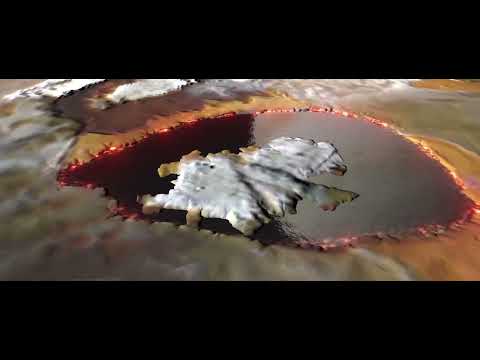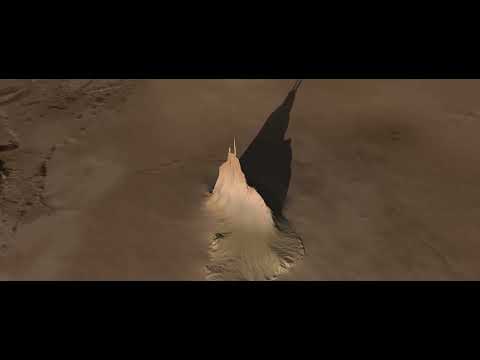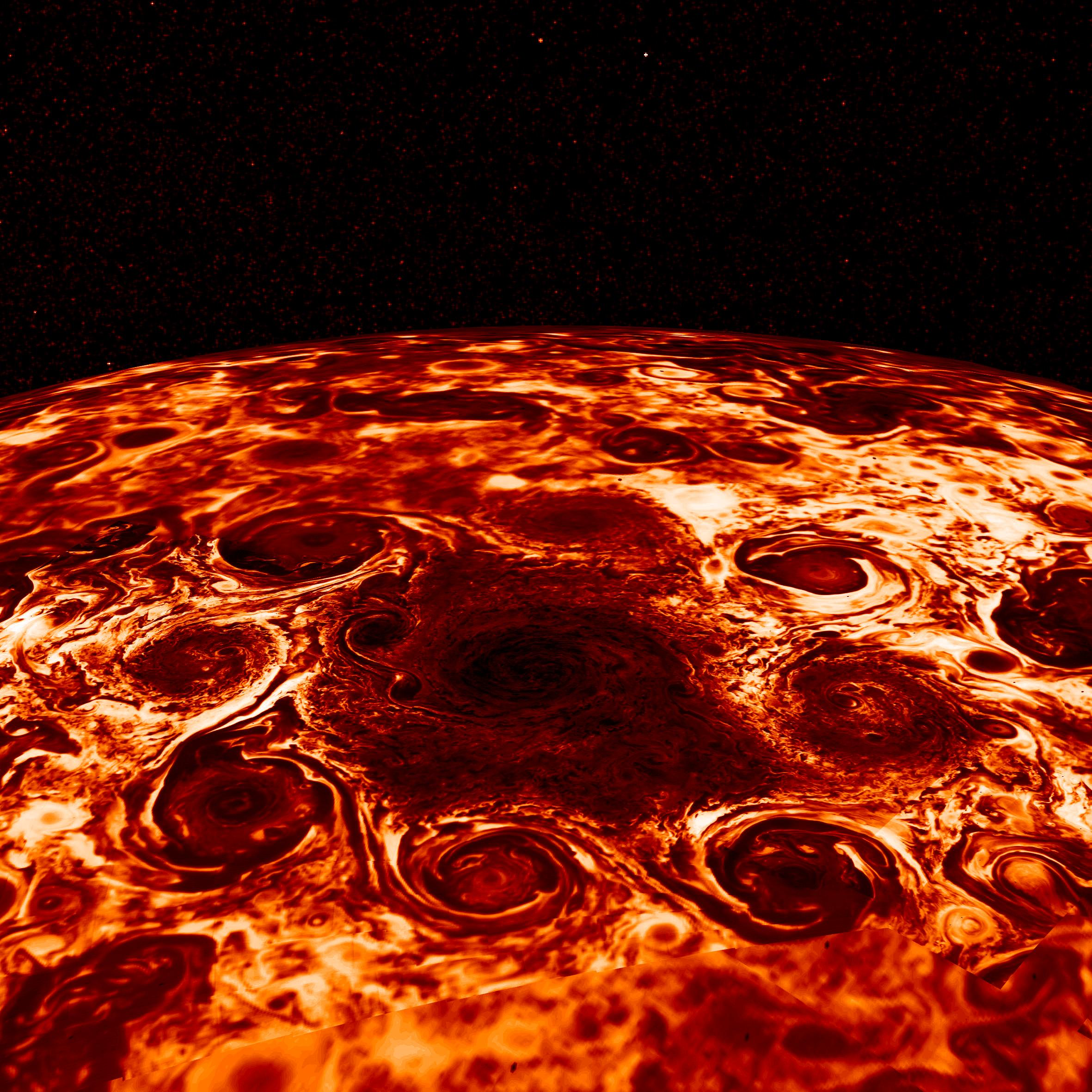NASA’s Juno mission scientists have used complex data collected during two flybys of Jupiter’s third largest moon Io to create animations that highlight this moon’s most dramatic features. Io is a little bit larger than the planet Earth and is also home to a mountain with a smooth lake of lava. Lava lakes like Io’s Loki Patera have a cooling surface crust that slowly thickens until it becomes denser than the underlying magma. It then sinks and pulls in the nearby crust.
First launched in 2011, Juno arrived at our solar system’s largest planet in 2016 with a mission to explore the Jovian system. It has 95 known moons and its four largest–Io, Europa, Ganymede, and Callisto–are called the Galilean moons. Io is most volcanically active.

This animation is an artist’s concept of Loki Patera, a lava lake on Jupiter’s moon Io, made using data from the JunoCam imager aboard NASA’s Juno spacecraft. With multiple islands in its interior, Loki is a depression filled with magma and rimmed with molten lava. CREDIT: NASA/JPL-Caltech/SwRI/MSSS.
“Io is simply littered with volcanoes, and we caught a few of them in action,” Juno’s principal investigator Scott Bolton said in a statement. “We also got some great close-ups and other data on a 200-kilometer-long [127-mile-long] lava lake called Loki Patera. There is amazing detail showing these crazy islands embedded in the middle of a potentially magma lake rimmed with hot lava. The specular reflection our instruments recorded of the lake suggests parts of Io’s surface are as smooth as glass, reminiscent of volcanically created obsidian glass on Earth.”
The observations were announced April 16 during the European Geophysical Union General Assembly in Vienna, Austria.
[Related: See the most volcanic world in our solar system in new NASA images.]
Juno conducted very close flybys of Io in December 2023 and February 2024, getting within 930 miles of the surface. The spacecraft obtained first close-up images of Io’s northern latitudes. Maps created with data collected by Juno’s Microwave Radiometer (MWR) instrument show that Io has a surface that is more smooth compared to Jupiter’s other Galilean moons, but also has poles that are colder than their middle latitudes.

Created using data collected by the JunoCam imager aboard NASA’s Juno during flybys in December 2023 and February 2024, this animation is an artist’s concept of a feature on the Jovian moon Io that the mission science team nicknamed “Steeple Mountain.” CREDIT: NASA/JPL-Caltech/SwRI/MSSS
Mountains and polar cyclones
With every pass, Juno flies closer to the north pole of Jupiter. Changing the spacecraft’s orientation allows the MWR instrument to improve its resolution of Jupiter’s northern polar cyclones. These storms at the top of the gas giant can reach wind speeds of 220 miles per hour and the data collected by Juno reveals that not all polar cyclones are created equal.
“Perhaps [the] most striking example of this disparity can be found with the central cyclone at Jupiter’s north pole,” Steve Levin, Juno’s project scientist at NASA’s Jet Propulsion Laboratory, said in a statement. “It is clearly visible in both infrared and visible light images, but its microwave signature is nowhere near as strong as other nearby storms. This tells us that its subsurface structure must be very different from these other cyclones. The MWR team continues to collect more and better microwave data with every orbit, so we anticipate developing a more detailed 3D map of these intriguing polar storms.”

Just how much water is on Jupiter? An enduring mystery
One of Juno’s primary science goals is to collect data that will help astronomers better understand Jupiter’s water abundance. However, the team isn’t looking for liquid water. Instead, they are studying Jupiterl’s atmosphere to quantify the presence of the molecules that make up water–oxygen and hydrogen. According to NASA, an accurate estimate of oxygen and hydrogen molecules present in Jupiter’s atmosphere is crucial to unlocking some of the underlying mysteries of how our solar system formed.
Jupiter was likely the first planet to form roughly 4.5 billion years ago. It also contains most of the gas and dust that wasn’t incorporated into the sun when the solar system formed. Water abundance also has important implications for Jupiter’s meteorology and internal structure.
[Related: Juno finally got close enough to Jupiter’s Great Red Spot to measure its depth.]
In 1995, NASA’s Galileo probe provided early data on the amount of water on Jupiter, but the data created more questions than answers. It showed that the gas giant’s atmosphere was unexpectedly hot and actually deprived of water—contrary to what computer models had initially indicated.
“The probe did amazing science, but its data was so far afield from our models of Jupiter’s water abundance that we considered whether the location it sampled could be an outlier. But before Juno, we couldn’t confirm,” said Bolton. “Now, with recent results made with MWR data, we have nailed down that the water abundance near Jupiter’s equator is roughly three to four times the solar abundance when compared to hydrogen. This definitively demonstrates that the Galileo probe’s entry site was an anomalously dry, desert-like region.”
[Related: Jupiter’s icy ocean worlds could be cool travel destinations in the future.]
The new results support the idea that sometime during the formation of our solar-system, water-ice material may have been the source of heavy element enrichment. These are chemical elements that are heavier than hydrogen and helium that Jupiter accumulated. The planet’s formation remains puzzling, because Juno’s results on the core of the gas giant suggest that there is very low water abundance. How abundant H20 is on the gas giant remains a mystery that the Juno mission could potentially solve.
What’s next for Juno
Data during the reminder of Juno’s mission could help determine how much water is on Jupiter in two ways. It could enable scientists to compare Jupiter’s water abundance near the polar regions to the equatorial region. It also may shed additional light on the structure of the planet’s dilute liquid core.
Juno’s most recent flyby of Io was on April 9 and the spacecraft came within about 10,250 miles of the moon’s surface. Its 61st flyby of Jupiter is scheduled for May 12 and it will continue to explore the planet and its moons through September 2025.





